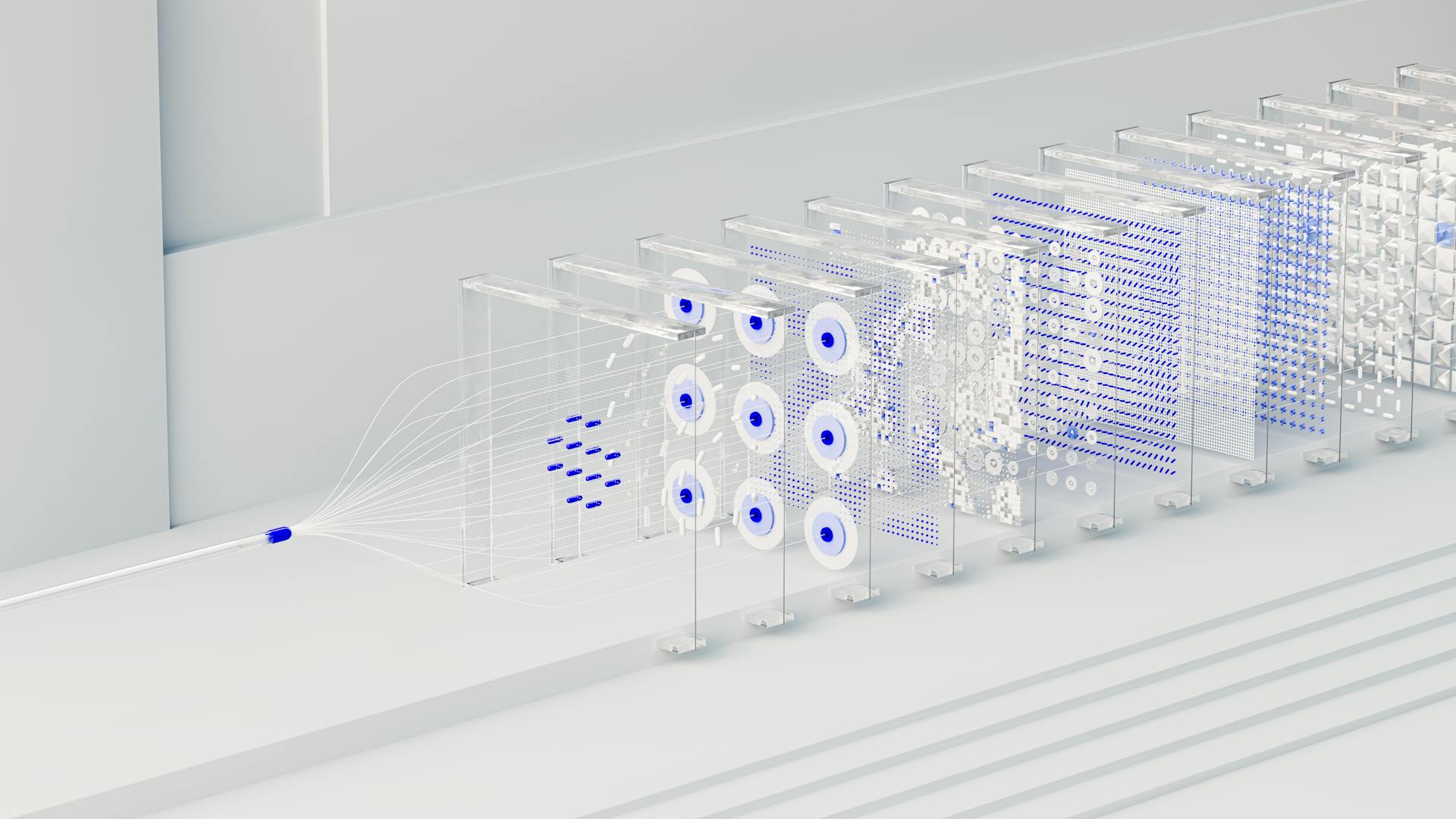
Overfitting is a major issue in machine learning, causing models to perform poorly on new, unseen data. According to our research, a well-known example of overfitting is the "Boston Housing" dataset, where a model learned to predict housing prices based on a few specific features, but failed to generalize to other areas.
To avoid overfitting, AutoML (Automated Machine Learning) algorithms can be used to automatically select the best model and hyperparameters for a given problem. By using a combination of techniques such as cross-validation and regularization, AutoML can help prevent models from becoming too complex and overfitting to the training data.
One of the key benefits of AutoML is that it can help identify the most important features in a dataset, reducing the risk of overfitting by eliminating irrelevant or redundant features. For example, in the "Wine Quality" dataset, AutoML was able to identify the most important features, such as alcohol content and pH levels, and use them to build a more accurate model.
Preventing Overfitting
Preventing Overfitting is crucial in Machine Learning, and there are several effective ways to do it. One way is to use regularization, which artificially forces your model to be simpler.
Regularization is a broad range of techniques that can be used to prevent overfitting. For example, you can prune a decision tree, use dropout on a neural network, or add a penalty parameter to the cost function in regression.
Early stopping is another technique that can help prevent overfitting. This involves stopping the training process before the learner passes a certain point where the model starts to overfit the training data.
Detecting overfitting is useful, but it doesn't solve the problem. Fortunately, you have several options to try, such as built-in feature selection in some algorithms.
You can also start with a very simple model to serve as a benchmark, and then try more complex algorithms. This is the Occam's razor test, where if two models have comparable performance, you should usually pick the simpler one.
In a hypothetical situation, you could perform a grid search across all different pipeline configurations and parameters, but even this wouldn't solve the issue of overfitting. You'd need to have access to large numbers of cases to make the performance estimation uncertainty negligible.
Explore further: Auto Ml Perfect Performance Stack
Detecting Overfitting in Machine Learning
Detecting overfitting in machine learning is crucial to avoid poor performance on new data. Overfitting occurs when a model is too complex and performs well on the training data but poorly on new data.
A key challenge with overfitting is that we can't know how well our model will perform on new data until we actually test it. To address this, we can split our initial dataset into separate training and test subsets.
One way to detect overfitting is to compare the model's performance on the training set with its performance on the test set. If the model performs much better on the training set than on the test set, then we're likely overfitting.
For example, if our model saw 99% accuracy on the training set but only 55% accuracy on the test set, that would be a big red flag. Another tip is to start with a very simple model to serve as a benchmark.
The Occam's razor test suggests that if two models have comparable performance, we should usually pick the simpler one. This approach helps us avoid overfitting by favoring simpler models that are less likely to overfit.
Here are some signs that may indicate overfitting:
- High variance in the model's performance across different folds
- Coefficient of variance exceeding 0.2
- Model performing much better on the training set than on the test set
Cross-Validation Techniques
Cross-validation is a powerful preventative measure against overfitting. It works by generating multiple mini train-test splits using the initial training data to tune the model.
In k-fold cross-validation, the data is partitioned into k subsets, called folds. This allows you to iteratively train the algorithm on k-1 folds while using the remaining fold as the test set, known as the "holdout fold".
By default, EvalML performs 3-fold cross validation when building pipelines. This means it evaluates each pipeline 3 times using different sets of data for training and testing.
You can pass your own cross-validation object to be used during modeling, which can be any of the CV methods defined in scikit-learn or use a compatible API.
Understanding Overfitting
Overfitting occurs when a model is too simple, informed by too few features or regularized too much, making it inflexible in learning from the dataset.
Simple learners tend to have less variance in their predictions but more bias towards wrong outcomes. This is known as the Bias-Variance Tradeoff, where we can reduce error from bias but might increase error from variance as a result.
A key challenge with overfitting is that we can't know how well our model will perform on new data until we actually test it. To address this, we can split our initial dataset into separate training and test subsets, and if our model does much better on the training set than on the test set, then we're likely overfitting.
Detecting Label Leakage
Detecting Label Leakage is a crucial aspect of preventing overfitting. A common problem is having features that include information from your label in your training data.
EvalML provides a warning when it detects this may be the case. This warning is a sign that you need to investigate further.
In a simple example, EvalML warned about the input features leaked_feature and leak_feature_2, which are both very closely correlated with the label we are trying to predict.
The second way to find features that may be leaking label information is to look at the top features of the model after running an AutoML search. The top features in our model are the 2 leaked features.
Here's a list of the top features in our model:
Overfitting vs Underfitting
Overfitting and underfitting are two sides of the same coin in machine learning. While overfitting occurs when a model is too complex, underfitting happens when a model is too simple.
Underfitting occurs when a model is too simple, informed by too few features or regularized too much. This makes it inflexible in learning from the dataset.
Simple learners tend to have less variance in their predictions but more bias towards wrong outcomes. Think of the kid whose dad is an NBA player, an outlier that skews the relationship between height and age.
Overfitting, on the other hand, happens when a model is too complex and memorizes the noise in the data. This results in poor performance on new, unseen data, like the 50% accuracy on a new dataset of resumes.
Both overfitting and underfitting are forms of prediction error in machine learning, known as bias and variance. A well-functioning ML algorithm will separate the signal from the noise, avoiding both overfitting and underfitting.
Goodness of Fit
Goodness of fit refers to how closely a model's predicted values match the observed (true) values. A model that has learned the noise instead of the signal is considered "overfit" because it fits the training dataset but has poor fit with new datasets.
To check the goodness of fit, we can split our initial dataset into separate training and test subsets. This will help us see if our model performs better on the training set than on the test set.
A big red flag is if our model sees 99% accuracy on the training set but only 55% accuracy on the test set. This suggests that we're likely overfitting.
Using a very simple model as a benchmark can also help us check the goodness of fit. If two models have comparable performance, then we should usually pick the simpler one, which is the Occam's razor test.
Sources
- https://evalml.featurelabs.com/en/v0.10.0/automl/overfitting_protection.html
- https://elitedatascience.com/overfitting-in-machine-learning
- https://medium.com/analytics-vidhya/can-you-trust-automl-3a02332e66a0
- https://stats.stackexchange.com/questions/306070/overfitting-during-model-selection-automl-vs-grid-search
- https://protonautoml.medium.com/how-to-avoid-overfitting-when-using-a-random-forest-f2b900857160
Featured Images: pexels.com

